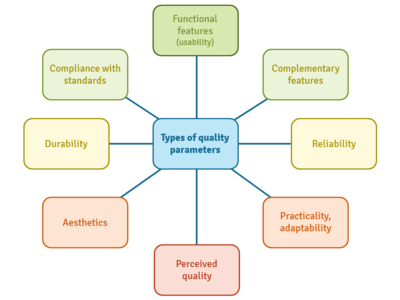Quality parameters
Quality parameter - the size characterizing the quality level of certain consumer and production goods and processes leading to the production of a given good.
The quality is described by eight dimensions characterizing, in various respects, the data of good and determining their essence and purpose, i.e.:
- functional features of the product, usability in accordance with the characteristics of the essence of the object,
- features that complement the basic functional features of the product,
- reliability, ability to work trouble-free,
- practicality, adaptability of the product, ease of use and maintenance,
- compliance with the standard requirements,
- durability, the possibility of using the product for a limited time,
- aesthetics, product reception,
- perceived quality, closely related to the product's brand and supplier's reputation.
These criteria are dynamic and depend on the following elements:
- industry,
- users,
- society,
- nature.
The quality parameters are determined by the actual condition of the company and its surroundings as well as the properties of raw materials and the technological process used during production. Improperly used technologies, inadequate environment of production processes, poor storage and transport may negatively affect product quality. These parameters can also be divided according to the group of features that contain a specific number and type of detailed qualitative characteristics depending on the needs to be met. These are:
- Natural and technical features, all product features given to them by nature or obtained as a result of technological processes, according to standards containing basic parameters of structure and function of these products. This group consists of physical, chemical and biological distinctions). They have an objective character, because they can be compared with existing patterns.
- Economic features are elements of the quality structure of goods that give users a measurable sum of benefits. Expressed using economic indicators, e.g. depreciation.
- The functional features make the products able to satisfy material (technical) as well as intangible (brand image, i.e. branded product) consumer needs. These are, for example, durability, ease of use and maintenance, comfort in use.
- Ergonomic properties, adjustment of products to anatomical, physiological and psychological features of a human being.
- Aesthetic features that characterize the appearance. They are shape, colors, external construction solutions.
- Ecological features, determined by the properties of goods, making them environmentally friendly.
When to use Quality parameters
Quality parameters are used to help ensure that a product or service meets customer expectations and is of the highest possible quality. Quality parameters can be used in a variety of different contexts, such as during the design phase of a product or service, during the production or assembly process, and during the customer service experience. Quality parameters are also used to evaluate the performance of a product or service over time, as well as assessing the effectiveness of any changes made to a product or service. By using quality parameters, companies can ensure that they are providing the highest quality product or service to their customers.
Advantages of Quality parameters
Quality parameters have numerous advantages for both businesses and customers. For businesses, quality parameters provide a way to measure the performance of a product or service and identify areas of improvement. They also help businesses set standards for their products or services and ensure that customers are receiving quality products or services at a fair price. For customers, quality parameters provide assurance that the product or service they are purchasing is of a high quality and meets their needs. Additionally, quality parameters help customers compare products or services and make informed purchasing decisions.
Limitations of Quality parameters
Quality parameters have their limitations in that they can only be used to measure a certain set of criteria and cannot account for all variables. Quality parameters are subjective in nature and can be affected by external factors such as the environment, customer preferences, and the availability of resources. Additionally, quality parameters are often difficult to measure accurately due to the complexity of the products or services being evaluated. Furthermore, quality parameters do not always take into account customer satisfaction, which is an important factor in determining the overall quality of a product or service.
Other approaches related to quality parameters include Total Quality Management (TQM), Six Sigma, and Lean Six Sigma. Total Quality Management is a process-oriented approach that seeks to achieve customer satisfaction by continually improving the quality of products and services. Six Sigma is a data-driven approach that uses statistical methods to identify and eliminate errors in processes. Lean Six Sigma is a hybrid approach that combines the principles of both TQM and Six Sigma with an emphasis on reducing waste and increasing efficiency. Each of these approaches has its own distinct approach to quality and can be used to help organizations achieve their quality objectives.
Overall, there are a variety of approaches related to quality parameters that can help organizations ensure that they are providing quality products and services that meet customer needs.
| Quality parameters — recommended articles |
| Reliability — Designed quality — Process performance — RATER model — Ergonomic system — Performance specification — Quality control — SERVPERF — Capacity analysis |
References
- Gabszewicz, J. J., & Thisse, J. F. (1979). Price competition, quality and income disparities. Journal of economic theory, 20(3), 340-359.
- Schulz, H., Joubert, E., & Schütze, W. (2003). Quantification of quality parameters for reliable evaluation of green rooibos (Aspalathus linearis). European Food Research and Technology, 216(6), 539-543.
